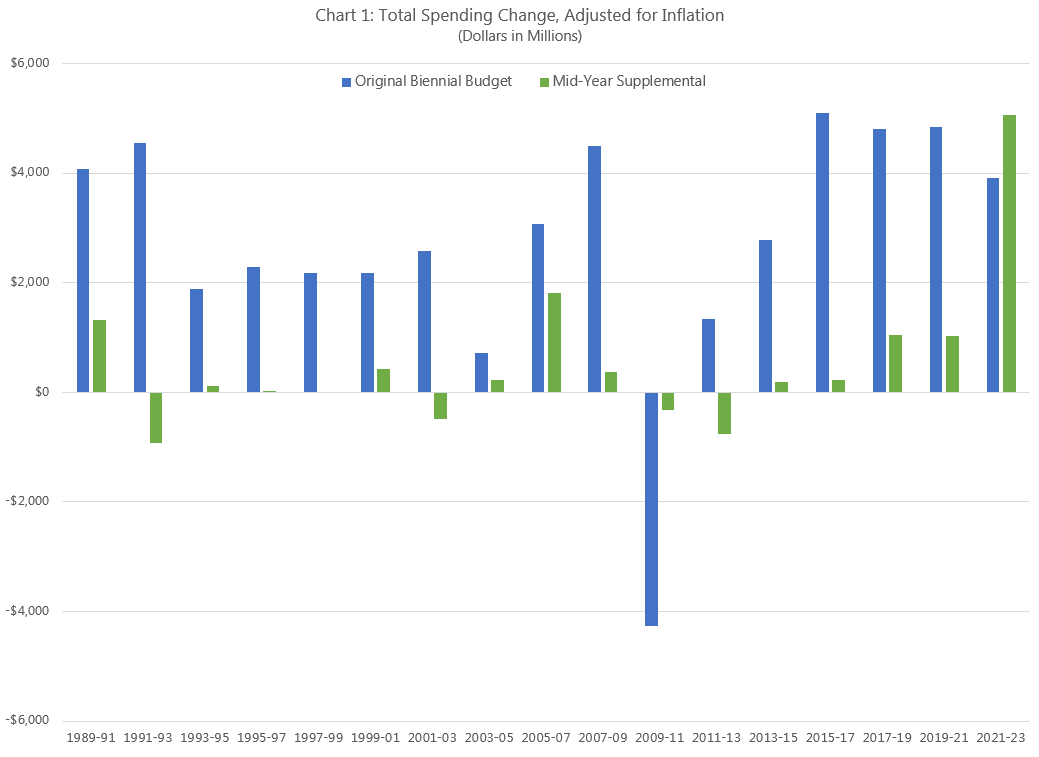(WASHINGTON RESEARCH COUNCIL)—In our policy brief comparing the House- and Senate-passed supplemental budgets, we included a chart showing that the proposed net changes in appropriations from funds subject to the outlook (NGFO) would be larger than previous supplementals and even larger or on par with previous biennial budgets. That chart went back to 2007–09.
Since then, I’ve collected earlier data from the state’s official Legislative Budget Notes (LBN) going back to 1989–91, and the point stands. (The budget notes for budgets before 1989 get a little spotty.)
The original enacted 2021–23 biennial budget increased NGFO appropriations by $3.911 billion. The 2022 supplemental budget as passed by the Legislature increased NGFO appropriations for the biennium by $5.071 billion. (The governor signed and partially vetoed the supplemental yesterday, but the effects of his vetoes are not yet clear.) This is the first time (going back to at least 1989–91) a supplemental has increased appropriations by more than the original budget for the same biennium.
Adjusted for inflation, the 2022 supplemental change is bigger than any prior biennial change except 2015–17. (See chart 1.) Adjusted for inflation and population, the 2022 supplemental change is bigger than any prior biennial change except 1989–91, 1991–93, and 2015–17. (See chart 2.) When you look at the combined change in the original biennial budget and the mid-biennium supplemental, the 2021–23 change is larger than in any other biennium (adjusted for inflation and population).

Of course, over time the budget has grown substantially. In the original 1989–91 budget, general fund–state appropriations totaled $12.516 billion. In the 2022 supplemental, NGFO appropriations total $64.138 billion. Looking at the budget change as a share of total appropriations in a biennium, the 2022 supplemental change is still larger than any other supplemental and is larger than eight original biennial budgets (out of 16). (See chart 3.)
You might be wondering: What was going on in 1989–91 and 1991–93? As the charts above show, the original biennial budgets included substantial spending increases. According to the 1989–91 LBN, the budget increased higher education and K–12 salaries, improved K–3 class size, enhanced instructional support services, and built more K–12 classrooms. The budget also expanded Medicaid to cover pregnant women and children in poverty. The spending increases were possible because of increased revenue forecasts and a change to how the ending balance from the previous biennium could be used.
As the Research Council noted about the 1990 supplemental process, “Previously, the ending fund balance went to reduce the unfunded liability of the pension system, but legislation passed last session provided a different mechanism for funding pensions and removed that requirement.” This meant that budget writers could use the $455.9 million ending balance from 1987–89 for spending in 1989–91.
Absent that process change, the WRC noted that the state was actually spending more than the available revenues. Moreover, the WRC reported that the 1990 budget would result in significantly higher costs in 1991–93 due to spending bow waves. The 1991–93 budget again spent more than forecasted revenues. Then the revenue forecast fell heading in to the 1992 legislative session.





